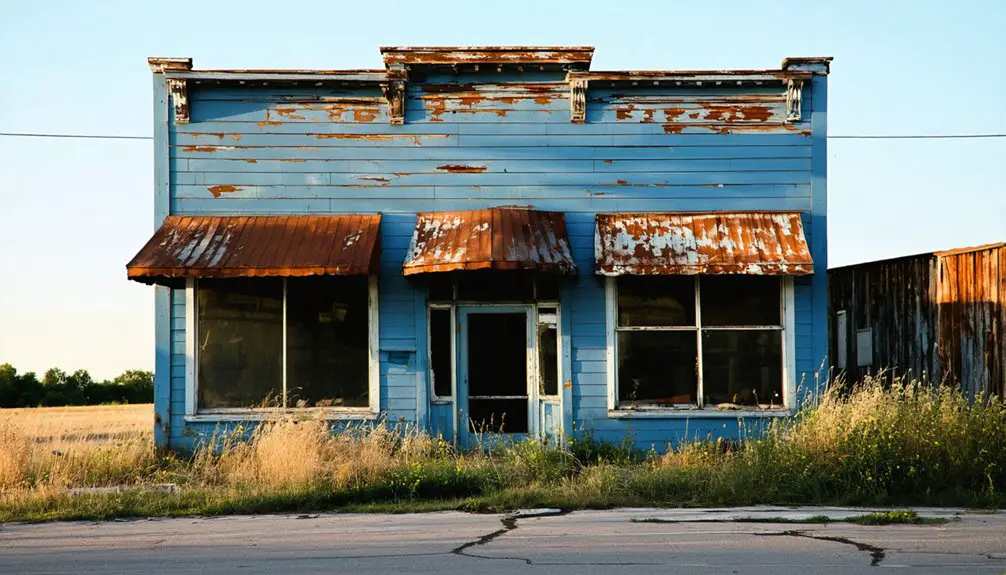You’ll find Addington along Oklahoma’s historic Chisholm Trail, where it emerged as a bustling railroad town in 1896. At its peak around 1915, nearly 1,000 residents enjoyed the town’s cotton gins, stockyards, and brick plant. A devastating bank robbery in 1928, followed by the Great Depression and Dust Bowl, triggered its decline. Today, fewer than 100 residents remain among the weathered brick storefronts and skeletal remains, each crumbling foundation whispering tales of past glory.
Key Takeaways
- Addington, Oklahoma transformed from a bustling railroad town of 1,000 residents in 1915 to fewer than 100 people today.
- A devastating bank robbery in 1928, followed by the Great Depression and Dust Bowl, initiated the town’s decline.
- The withdrawal of railroad services and rerouting of transportation networks isolated Addington from vital commerce routes.
- Main Street’s abandoned storefronts, collapsed buildings, and empty bank foundation reflect its ghost town status.
- Monument Hill and weathered brick structures remain as physical remnants of Addington’s prosperous past along the Chisholm Trail.
The Birth of a Railroad Town
When the Chicago, Rock Island and Pacific Railroad laid its tracks through Jefferson County in the 1890s, it planted the seeds for Addington’s birth along its right-of-way.
You’ll find the railroad’s impact echoed through every aspect of the town’s formation, from its strategic positioning along an old cattle trail to its rapid development as an agricultural hub.
In January 1896, James P. Addington became the town’s first postmaster, lending his name to this emerging community.
The town’s namesake took on the mantle of postmaster, marking a key milestone in Addington’s early development.
The settlement patterns that followed the railroad’s path led to Addington’s official incorporation in 1901. Like the historic Domesday Book from 1086, this incorporation marked an important documentation of the town’s existence.
You can trace the town’s early prosperity through the businesses that sprung up alongside the tracks – cotton gins, a lumberyard, brick plant, and stockyards, all evidence of the transformative power of rail commerce. The town’s growth was evident as two cotton gins operated shortly after Oklahoma achieved statehood.
Glory Days and Peak Population
During the peak of its prosperity around 1915, Addington swelled to approximately 1,000 residents, marking the town’s golden age of commerce and community life.
You’d have found a bustling town with two churches hosting regular community gatherings, while multiple newspapers like the Addington Herald kept citizens informed and connected.
The town’s strong local identity flourished through its diverse economy, anchored by two cotton gins, stockyards, and a brick plant. Agricultural activity thrived as farmers brought their cattle, hogs, cotton, and corn to market via the railroad.
The ambitious development plans of 1908 even anticipated housing for 1,500 families, reflecting the optimism of the era. Like many Oklahoma settlements, Addington eventually declined due to resource exhaustion and shifting economic patterns.
Two churches served as social hubs, weaving together the fabric of this close-knit farming community. A devastating bank robbery in 1928 marked the beginning of the town’s eventual decline into a ghost town.
Economic Pillars and Local Commerce
As a critical transportation hub along the Chicago, Rock Island and Pacific Railroad, Addington’s economic foundation rested firmly on agricultural commerce and processing industries.
You’d find a diverse agricultural landscape where cattle, hogs, cotton, and corn thrived alongside robust local manufacturing operations. Two cotton gins processed the region’s cotton harvests, while dual stockyards facilitated livestock trade. Similar to how oil company camps provided better living conditions than typical housing in boomtowns, Addington’s industrial facilities maintained higher operational standards. Like many towns that became ghost town reminders of Oklahoma’s past ambitions, Addington showcased remarkable economic potential. A lumberyard and brick plant rounded out the town’s industrial capacity, serving construction needs throughout Jefferson County.
The town’s strategic location near U.S. Highway 81 amplified its commercial reach, while newspapers like the Addington Herald and Addington Advertiser reflected a bustling business community.
Nestled along U.S. Highway 81, Addington’s prime location and active press coverage showcased its vibrant commercial spirit.
This agricultural diversification and processing infrastructure positioned Addington as an essential economic center until challenges of the late 1920s began to emerge.
The Slow Fade: Factors Behind the Decline
You’d have witnessed Addington’s slow unraveling through the 1930s, as economic hardships from the Great Depression and Dust Bowl drove families to abandon their homes and livelihoods.
The rerouting of major transportation arteries past the town gradually eliminated the steady flow of commerce that once sustained local businesses and services. Much like the destructive fires of 1908 that devastated other Oklahoma towns, repeated disasters took their toll on local infrastructure and morale. The pattern of decline mirrors nearby Sharon, which has dwindled to a mere 133 residents today.
Agricultural decline dealt the final blow, as cotton markets faltered and mechanization reduced the need for farm labor, leaving the once-bustling community to fade into obscurity.
Economic Forces Drive Exodus
While Addington once thrived as a bustling agricultural hub with two cotton gins, stockyards, and diverse agribusinesses in the early 1900s, the town’s economic foundation began crumbling after World War I.
You’d have witnessed the stark reality of rural decline as the farming economy stagnated and businesses shuttered. The Great Depression brought economic downturns that mirrored the fate of many Oklahoma towns. The 1928 bank closure, following armed robberies, dealt a devastating blow to local commerce and investment. Like Lordstown, Ohio’s vanishing workforce, the exodus of jobs triggered a chain reaction of decline.
By 1950, you’d have seen the population plummet to just 174 residents, down from 493 in 1910. Economic migration accelerated as younger generations sought opportunities elsewhere, leaving behind abandoned storefronts and quiet streets.
The absence of essential services, from grocery stores to financial institutions, created a downward spiral that transformed this once-prosperous farming community into a shadow of its former self.
Transportation Networks Fade Away
The Chicago, Rock Island and Pacific Railroad’s gradual withdrawal from Addington marked the beginning of the town’s transportation isolation in the early 1900s.
You can trace the town’s decline through the stark evolution of its rail roadways, as the once-bustling station that handled cattle shipments and passenger service fell silent.
The transportation evolution hit Addington particularly hard when U.S. Highway 81 couldn’t compensate for the lost rail connections that had been the town’s lifeblood.
Where steam engines once thundered past loaded with cattle and crops, you’ll now find only abandoned tracks.
The post office closed, the bank shuttered in 1928, and the school struggled to survive into the 1990s – each closure a reflection of your community’s fading transportation arteries.
Agricultural Markets Lost Ground
As cotton fields stretched across Addington’s fertile landscape in the early 1900s, two bustling cotton gins processed the town’s primary commodity crop.
Yet you’d soon witness a dramatic transformation as agricultural markets lost their footing, leading to the town’s slow decline.
By 1963, crop diversification painted a different picture across Jefferson County’s farmland:
- Cotton shrank to 11,500 acres
- Wheat expanded to 7,000 acres
- Oats claimed 5,900 acres
You’d have seen market accessibility crumble as rail service diminished and traditional cattle routes faded into memory.
The 1928 bank robbery dealt a devastating blow, eliminating essential financial services for local farmers.
Without access to credit or reliable transportation for their goods, many farmers abandoned their dreams, seeking opportunities elsewhere as Addington’s agricultural economy withered.
Historic Buildings and Remnants Today
If you walk down Addington’s Main Street today, you’ll find little trace of the once-bustling storefronts and civic buildings that defined this frontier town.
The town’s bank, shuttered after a 1928 robbery, now exists only in foundations, while the school that educated generations of local children has completely vanished.
You’ll spot just the stark holding cell and the hilltop monument as the last tangible reminders of Addington’s more prosperous era.
Abandoned Main Street Structures
Main Street’s skeletal remains tell a haunting story of Addington’s former liveliness, where weathered brick storefronts and collapsed wooden structures line the quiet thoroughfare.
Urban decay has transformed once-bustling commercial buildings into silent witnesses of time, their architectural remnants hinting at the town’s prosperous past.
You’ll find evidence of Addington’s commercial heritage through:
- Hollow shells of former general stores and hotels, their boarded windows staring blindly at empty streets
- Deteriorating brick buildings that showcase the town’s old brick plant legacy
- Abandoned cotton gins and lumberyards that once drove the agricultural economy
These architectural ghosts stand as proof of Addington’s shift from a thriving railroad town of nearly 500 residents to today’s quiet community of fewer than 100 souls.
Former Civic Buildings Today
While many of Addington’s original civic buildings have succumbed to time, several historic structures still stand as evidence to the town’s institutional past.
You’ll find the 1896 post office building, a reflection of early Oklahoma civic architecture, alongside two preserved churches from the early 1900s, complete with period stained glass windows.
The pre-WWI schoolhouse remains as one of the largest historic structures, with its gymnasium and auditorium still recognizable despite decay.
A 1920s cement jail reflects the town’s law enforcement history, while partial remains of the former bank building, which closed after robberies in 1928, hint at tumultuous times.
Historic preservation efforts have maintained these landmarks, though abandoned, as silent storytellers of Addington’s once-thriving institutional life.
Legacy in Oklahoma’s Rural History

Although Addington’s population has dwindled to fewer than 100 residents, its legacy endures as a quintessential example of Oklahoma’s rural development patterns.
Like many Oklahoma prairie towns, Addington’s quiet streets tell a story of rural transformation and enduring heritage.
You’ll find this ghost town‘s rural heritage woven into the very fabric of the state’s history, from its railroad-driven beginnings to its agricultural prominence.
The town’s story captures three defining elements of Oklahoma’s development:
- The transformative power of the railroad, which established Addington as a crucial trade hub in the 1890s
- The agricultural boom that brought cotton gins, stockyards, and prosperity during the early statehood era
- The dramatic shifts in rural economies that led many small towns to decline after World War I
Monument Hill stands as a silent sentinel, reminding you of Addington’s connection to the historic Chisholm Trail and its cattle-driving past.
Frequently Asked Questions
Are There Any Paranormal or Haunted Locations Reported in Addington?
While you’ll hear whispers of local legends, there aren’t any officially documented ghost sightings in the area. The town’s abandoned buildings and decline have inspired stories, but they lack credible verification.
What Happened to the Original Residents’ Descendants After Leaving Addington?
Like scattered seeds from Addington’s cotton fields, you’ll find descendants spread to Waurika, Ardmore, and beyond – moving for jobs while keeping their legacy alive through family stories and reunions.
Does Anyone Still Maintain the Town’s Historic Cemetery?
You’ll find no official cemetery maintenance program actively caring for Addington’s historic cemetery today, though local volunteers or tribal organizations may occasionally contribute to basic historic preservation efforts when possible.
Were There Any Famous People or Notable Events Associated With Addington?
While the town once bustled with 1,000 residents in 1915, you won’t find many notable residents in historical records except James P. Addington, the first postmaster who lent his name to the settlement.
Can Visitors Legally Explore and Photograph the Remaining Buildings Today?
You’ll need property owners’ permission before exploring or photographing buildings, as exploration rules require consent. Photography permits aren’t standardized, but trespassing laws apply to all structures on private land.
References
- https://en.wikipedia.org/wiki/List_of_ghost_towns_in_Oklahoma
- https://www.okhistory.org/publications/enc/entry?entry=AD006
- https://www.redriverhistorian.com/videos
- https://www.youtube.com/watch?v=sK17sYXwUSQ
- https://en.wikipedia.org/wiki/Addington
- https://kids.kiddle.co/Addington
- https://www.okhistory.org/publications/enc/entry?entry=JE001
- https://kids.kiddle.co/List_of_ghost_towns_in_Oklahoma
- https://jrap.scholasticahq.com/api/v1/articles/9543-the-economics-of-ghost-towns.pdf
- https://nondoc.com/2022/01/04/whizbang-oklahoma-ghost-town/



